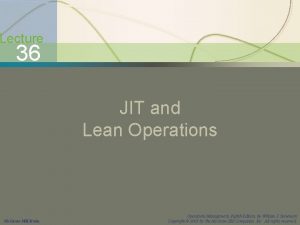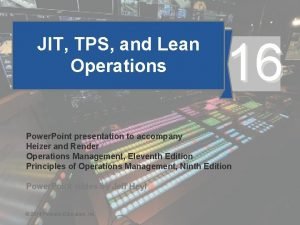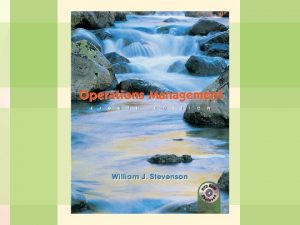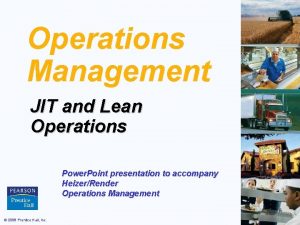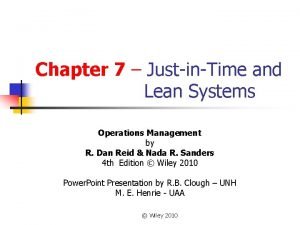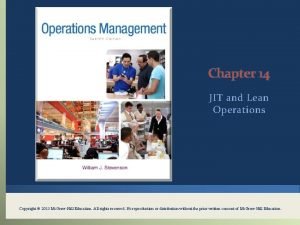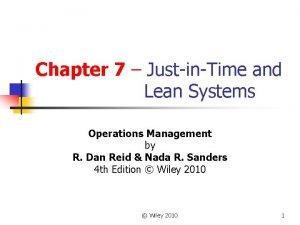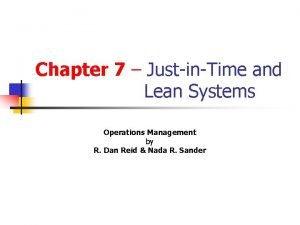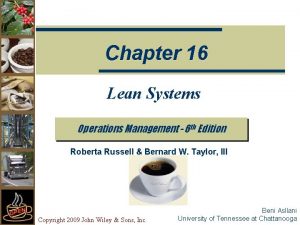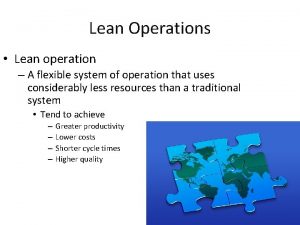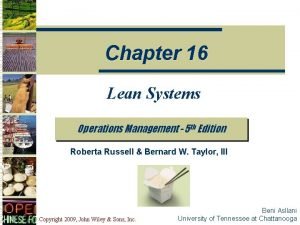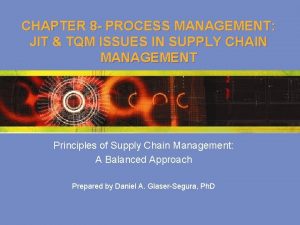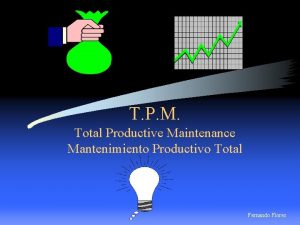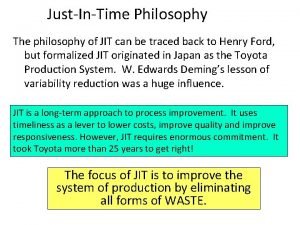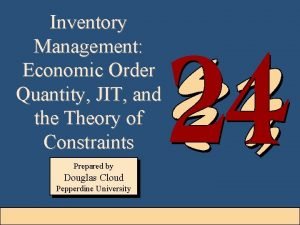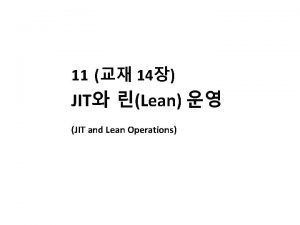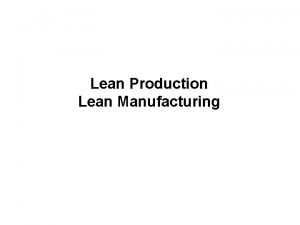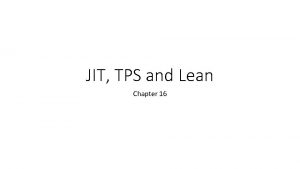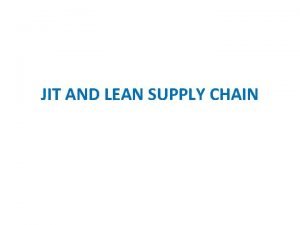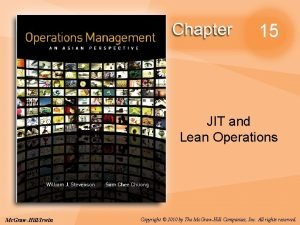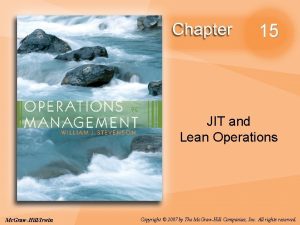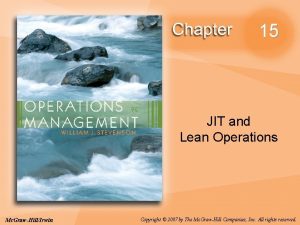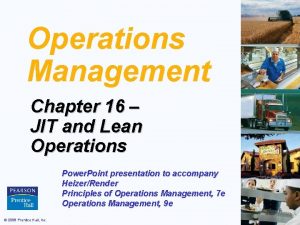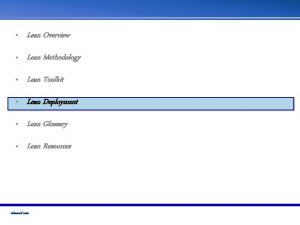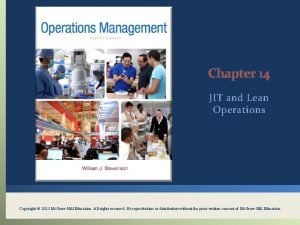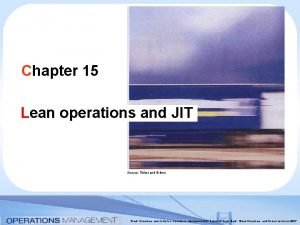Chapter 14 JIT and Lean Operations Mc GrawHillIrwin















- Slides: 15

Chapter 14 JIT and Lean Operations Mc. Graw-Hill/Irwin Copyright © 2012 by The Mc. Graw-Hill Companies, Inc. All rights reserved.

Chapter 14: Learning Objectives You should be able to: 1. Explain what is meant by the term lean operations system 2. List each of the goals of a lean system and explain its importance 3. List and briefly describe the building blocks of lean 4. List the benefits of a lean system 5. Outline the considerations important in converting a traditional mode of operations to a lean system 6. Point out some of the obstacles that might be encountered when converting to a lean system 7. Describe value stream mapping Student Slides 14 -2

Lean Operations Lean operation A flexible system of operation that uses considerably less resources than a traditional system Tend to achieve Greater productivity Lower costs Shorter cycle times Higher quality Student Slides 14 -3

Lean: Ultimate Goal The ultimate goal: Achieve a system that matches supply to customer demand in a smooth uninterrupted flow A balanced system One that achieves a smooth, rapid flow of materials and/or work through the system Student Slides 14 -4

Goals and building blocks of lean systems Student Slides 14 -5

Lean: Supporting Goals The lean’s ultimate goal is achieved by its supporting goals: Eliminate disruptions 2. Make the system flexible 3. Eliminate waste, especially excess inventory 1. Student Slides 14 -6

Lean: Building Blocks Product design Process design Personnel/organizational elements Manufacturing planning and control Student Slides 14 -7

Building Blocks: Personnel/Organizational Five personnel/organizational elements important to lean systems: Workers as assets Cross-trained workers Continuous improvement Cost accounting Leadership/project management Student Slides 14 -8

Building Blocks: MPC Seven elements of manufacturing planning and control (MPC) are particularly important for lean system: 1. 2. 3. 4. 5. 6. 7. Level loading Pull systems Visual systems Limited work-in-process (WIP) Close vendor relationships Reduced transaction processing Preventive maintenance and housekeeping Student Slides 14 -9

MPC: Pull Systems Push system Work is pushed to the next station as it is completed Pull system A workstation pulls output from the preceding workstation as it is needed Output of the final operation is pulled by customer demand or the master schedule Pull systems are not appropriate for all operations Large variations in volume, product mix, or product design will undermine the system Student Slides 14 -10

MPC: Visual Systems Kanban Card or other device that communicates demand for work or materials from the preceding station Kanban is the Japanese word meaning “signal” or “visible record” Paperless production control system Authority to pull, or produce, comes from a downstream process. Two main types of kanbans: 1. Production kanban (p-kanban): signals the need to produce parts 2. Conveyance kanban (c-kanban): signals the need to deliver parts to the next work center. Student Slides 14 -11

Kanbans Ideal number of kanban cards Student Slides 14 -12

Transitioning to Lean Systems 1. Make sure top management is committed and that they know what will be required 2. Decide which parts will need the most effort to convert 3. Obtain support and cooperation of workers 4. Begin by trying to reduce setup times while maintaining the current system 5. Gradually convert operations, begin at the end and work backwards 6. Convert suppliers to JIT 7. Prepare for obstacles Student Slides 14 -13

Obstacles to Conversion 1. Management may not be fully committed or willing to devote the necessary resources to conversion 2. Workers/management may not be cooperative 3. It can be difficult to change the organizational culture to one consistent with the lean philosophy 4. Suppliers may resist Student Slides 14 -14

Operations Strategy Be careful to study the requirements and benefits of lean systems before making a decision to convert operations Evaluate strengths and weaknesses of current operations The decision to convert can be sequential Weigh the pros and cons of a lean approach to inventories Supplier management is critical to a lean operation Student Slides 14 -15
 Jit and lean production
Jit and lean production Jit tps and lean operations
Jit tps and lean operations Jit building blocks
Jit building blocks эътиборингиз учун раҳмат
эътиборингиз учун раҳмат Lean systems operations management
Lean systems operations management Building blocks of jit
Building blocks of jit Lean systems operations management
Lean systems operations management Lean systems operations management
Lean systems operations management A production kanban authorizes a worker to:
A production kanban authorizes a worker to: The ultimate goal in a lean system is:
The ultimate goal in a lean system is: Lean systems operations management
Lean systems operations management Jit and tqm issues in supply chain management
Jit and tqm issues in supply chain management Warp jit service
Warp jit service Estructura del tpm
Estructura del tpm Just-in-time philosophy
Just-in-time philosophy 15670t
15670t
